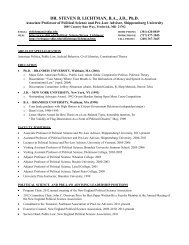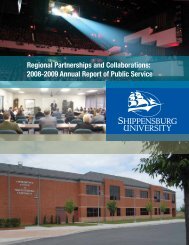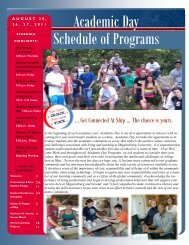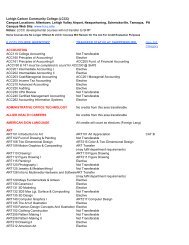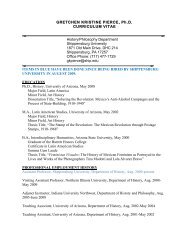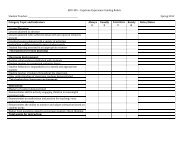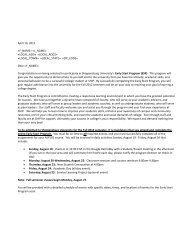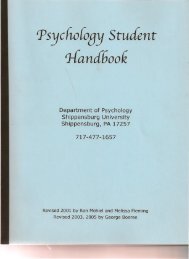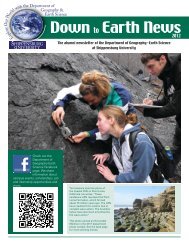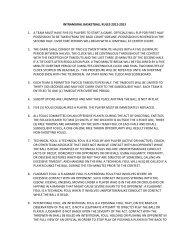Complete Issue - Shippensburg University
Complete Issue - Shippensburg University
Complete Issue - Shippensburg University
- No tags were found...
You also want an ePaper? Increase the reach of your titles
YUMPU automatically turns print PDFs into web optimized ePapers that Google loves.
Beatrice Marelli: Irrigation Systems and Values 31According to Weber, a collective belief is formedwhen its content becomes an object of adhesion byindividuals (Boudon 1997); this occurs only if validreasons for accepting it do exist (deutend Verstehen).The theory of collective beliefs can be interpreted ina manner that has to be concerned with rationalitybecause these beliefs are felt as strong by social actors.According to Boudon (2000), a theory is rationalin a cognitive sense when it leans on reasons oftheoretical character the actor believes are strong inthat particular context (values rationality, according toWeber). The advantage of this vision in comparisonwith the irrational one is it easily explains essentialphenomenological data: the actors have a sense ofconviction, not internalisation or constraint. Theimplicit or not directly observable character of thereasons, both at the individual and the collectivelevels, does not jeopardize the scientific quality of ananalysis based on them. Such issue has given supportto the present research, since it stresses the fact thatwhen an interaction system has an interest for all theparticipants, the operation rules derived from it obtaina positive value. The exploitation process linked withgoverning a common pool resource allows a group ofusers to give a content to the concept of axiologicalrationality.Hypothesis and method of investigationThe hypothesis suggests individual values are thedetermining variables in social networking and in theinstitutional crafting of governing natural resources.In particular, Ostrom’s model explains decisions at themicro level of the interaction substantially affecting themanagement and the evolution of small self-governingirrigation systems over time. Individual requests canbring the institutions, under certain conditions, tosubstitute the search for collective benefits derived fromthe resolution of common dilemmas with the pursuitof individual demands. This leads to an erosion of thecollective meaning of the institution itself, nullifyingthe realization of more broad community outcomes. Incontrast, under different conditions, internal values (i.e.Boudon’s axiological rationality) can be extremely usefulin increasing the institutional performance and incontrolling opportunistic behaviours. According to sucha hypothesis, the levels of trust and trustworthinessamong community members are important explanativevariables because they further the learning processenabling it to generate availability of mutual socialinteractions. For the achievement of a sustainableinstitutional arrangement governing water resources,the existence of the feedback loop among trust,reputation, and reciprocity is highly desirable.I explored this issue investigating how two smallfarm communities in northern Italy have managedwater over time, focusing on the values they applied inthis self-governance process. I selected these two groupsbecause they share the same physical attributes of theresources in use and the same institutional structure,but show different outcomes in terms of sustainablemanagement of natural irrigation streams.The theoretical purpose is achieved with aqualitative method of investigation to focus oninternal values and emotional feelings among theactors involved in the resource management. Forcollecting the data, in-depth semi-structured interviewswere conducted with half of the members of eachcommunity.The case studiesBoth case studies analyzed in this research (RoggiaLa Farfenga and Roggia La Gabbiana) are basedon the plain area south of the city of Brescia, in theLombardy region of northern Italy. They are consortia:self-governed irrigation groups (supported at thelocal and regional government level) with the aim ofallowing farmers to use the resources available on theirland autonomously. These organizations were aimedto manage both the water naturally available from thebasins presented in the ground area of the municipalityand the network of man-made channels necessary forirrigation purposes during the farming dry season. Theconsortia have traditionally occupied substantial part inthe agricultural environment of the area, since the landwhere the two groups are placed in is characterizedby richness in sand and poorness in clay. For thisreason, the fields have always required important flowsof water for the maintenance of a minimum level ofproductivity of the different crops developed for thelivelihood of the local population, whose main activityhistorically is farming. Located between the Alps andthe rich land of the Padana plain, these communitiesdid not face difficulty in capturing the right quantityof water needed for their fields until they had adopteda traditional rotation of crops, based on periodicalchanges of the exploited areas that guaranteedregeneration of the soil and a constant care for thewhole network of ditches.Both institutions were informally established bythe end of the 19th century in the same municipality’sterritory (Borgo San Giacomo) by autonomous groupsof farmers who, in common, were exploiting irrigationditches.The Farfenga consortium spans two different localmunicipalities, Borgo San Giacomo and Orzinuovi,following the Roggia Farfenga, the spring-fed river thatconstitutes the main source of water for the agriculturecommunity. It is composed of three different streamsthat join in the locality of Rossa, Orzinuovi, the headof the central water basin, for an extension of 2.5, 1.7and 1.6 km respectively in a north-south direction. Inthis first branch we find natural springs that generateenough water for irrigation. In the second and thirdbranches the main part of the natural flow comes froma few natural springs in minor channels. The threebranches link around half a kilometre before the first



